I hate puppets. Uncanny, scary, they are too much like us, especially when they have a life of their own. Dolls are just as bad. Ventriloquist dummies give me the creeps. Basically, any homunculus or simulacrum of the human unsettles and delights the soul.
Perhaps that’s a strange thing to admit, given that my new novel The Motion of Puppets is, in part, about a strange troupe of puppets that come to life every evening in the back of toy shop in Quebec. When I was a young boy, I saw an old “Merrie Melodies” cartoon that showed how the toys would have a party after midnight and return to their places before the next dawn. That cartoon was one of those fantasias that left a lifelong impression on me.
Puppet shows are also weird and eerie. I grew up on the Muppets and the other creatures from Jim Henson’s imagination, and lately enjoyed the work of the Bread and Puppet Theatre, Basil Twist, and the Old Trout Puppet Company—among others—that take the stuff of childhood and torque them into adult puppet shows that breathe and hum and tug at the psyche. Two wonderfully strange books about the history and culture of puppets are Victoria Nelson’s The Secret Life of Puppets and Kevin Gross’s Puppet: An Essay on Uncanny Life.
Living dolls and puppets are the subject of a number of novels and stories, some of which came into play when I concocted my story that takes the Orpheus and Eurydice myth and sets the underworld in puppetland. The puppet characters kind of grew on me, to the point where I love them as well. They pulled my strings, so to speak. So it is a love-hate kind of thing on my part. I have no idea how they feel about me.
Here are five other books about puppets and living dolls:
The Adventures of Pinocchio by Carlo Collodi
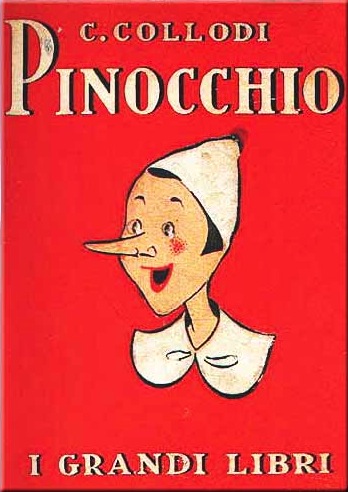 Not the Disneyfied version (though that, too, has its own charms), but Carlo Collodi’s classic tale of the puppet who would be a boy. Like all good children’s literature, Pinocchio has a subversive heart that beats for adults. And while the story is now a cultural icon, read it and you’ll be surprised at how it differs from your expectations. Some of the familiar elements are in Collodi: the growing nose, the lying, the transformation into a donkey, the whale-like great fish. But the Italian original is darker, funnier, and more deeply unsettling. You won’t believe what happens to the cricket.
Not the Disneyfied version (though that, too, has its own charms), but Carlo Collodi’s classic tale of the puppet who would be a boy. Like all good children’s literature, Pinocchio has a subversive heart that beats for adults. And while the story is now a cultural icon, read it and you’ll be surprised at how it differs from your expectations. Some of the familiar elements are in Collodi: the growing nose, the lying, the transformation into a donkey, the whale-like great fish. But the Italian original is darker, funnier, and more deeply unsettling. You won’t believe what happens to the cricket.
Coraline by Neil Gaiman
 The Other Mother is the stuff of nightmares, particularly the beldam who lures her victims with promises of hidden pleasures, an echo of Pinocchio there. Technically speaking, she may not be a doll or a puppet, but with her button eyes, she is surely drawn from the uncanny, the world where things are both human and not quite human at the same time. And the threat to have Coraline become part of her collection of lost souls is deeply disturbing. The film, which uses stop-motion puppetry, reinforces the magic spell cast by the book.
The Other Mother is the stuff of nightmares, particularly the beldam who lures her victims with promises of hidden pleasures, an echo of Pinocchio there. Technically speaking, she may not be a doll or a puppet, but with her button eyes, she is surely drawn from the uncanny, the world where things are both human and not quite human at the same time. And the threat to have Coraline become part of her collection of lost souls is deeply disturbing. The film, which uses stop-motion puppetry, reinforces the magic spell cast by the book.
Riddley Walker by Russell Hoban
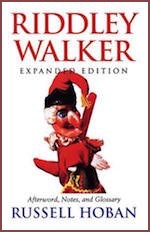 The post-apocalyptic world, set in the dark future where England is now Inland, and the language has evolved into this weird phonetic dialect. The moment when Ridley discovers the blackened puppet in the dump is mesmerizing. Of course, the puppet is Punch, from the classic Punch and Judy Show, and he becomes both a powerful way of connecting the mythos of the past with the broken future. What sort of list about puppet books would be complete without the original and freakish Punch? “This here figger his name is Punch which hes the oldes figger there is.” And he’s right. With roots in the 16th-century Italian commedia dell’arte, Mr. Punch made his first recorded appearance in England on May 9, 1662. Imagine, a puppet with a birthday. Better yet, leave it alone.
The post-apocalyptic world, set in the dark future where England is now Inland, and the language has evolved into this weird phonetic dialect. The moment when Ridley discovers the blackened puppet in the dump is mesmerizing. Of course, the puppet is Punch, from the classic Punch and Judy Show, and he becomes both a powerful way of connecting the mythos of the past with the broken future. What sort of list about puppet books would be complete without the original and freakish Punch? “This here figger his name is Punch which hes the oldes figger there is.” And he’s right. With roots in the 16th-century Italian commedia dell’arte, Mr. Punch made his first recorded appearance in England on May 9, 1662. Imagine, a puppet with a birthday. Better yet, leave it alone.
Enchanted Night by Steven Millhauser
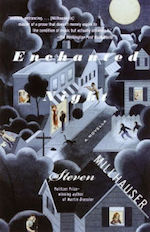 This novella, like much of Millhauser’s work, slips easily into the languor and magic of hidden kingdoms and miniature fantastical landscapes. Here a beautiful mannequin steps down from her department store window and into our world, and dolls “no longer believed in,” left abandoned by children in the attic, magically come hauntingly back. There are many more puppets and dolls, automata and living cartoons in Millhauser’s glorious stories. His particular magic is in setting a mood: “This is the night of revelation. This is the night the dolls wake. This is the night of the dreamer in the attic. This is the night of the piper in the woods.”
This novella, like much of Millhauser’s work, slips easily into the languor and magic of hidden kingdoms and miniature fantastical landscapes. Here a beautiful mannequin steps down from her department store window and into our world, and dolls “no longer believed in,” left abandoned by children in the attic, magically come hauntingly back. There are many more puppets and dolls, automata and living cartoons in Millhauser’s glorious stories. His particular magic is in setting a mood: “This is the night of revelation. This is the night the dolls wake. This is the night of the dreamer in the attic. This is the night of the piper in the woods.”
Doll Collection edited by Ellen Datlow
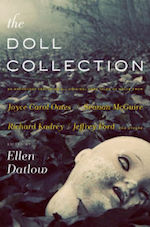 “Dolls,” Datlow writes in her introduction, “perhaps more than any other object, demonstrate just how thin the line between love and fear, comfort and horror, can be.” One of the great editors of science fiction, fantasy, and horror short fiction, Datlow crafted this anthology with one rule in mind: no clichéd evil doll stories. Instead, she brings us something truly creepy with takes on ventriloquism, a strange doll hospital, and my favorite, “The Word Doll,” about imaginary playmates. At her blow-out gothic best, Joyce Carol Oates brings us “The Doll-Master.” Seventeen tales by seventeen creepy people. And there are pictures. Of dolls. And doll parts. Yeesh.
“Dolls,” Datlow writes in her introduction, “perhaps more than any other object, demonstrate just how thin the line between love and fear, comfort and horror, can be.” One of the great editors of science fiction, fantasy, and horror short fiction, Datlow crafted this anthology with one rule in mind: no clichéd evil doll stories. Instead, she brings us something truly creepy with takes on ventriloquism, a strange doll hospital, and my favorite, “The Word Doll,” about imaginary playmates. At her blow-out gothic best, Joyce Carol Oates brings us “The Doll-Master.” Seventeen tales by seventeen creepy people. And there are pictures. Of dolls. And doll parts. Yeesh.
Top image: Pinocchio (1940)
 Keith Donohue is the author of five novels, including The Boy Who Drew Monsters (which includes an imaginary friend) and The Motion of Puppets, available now from Picador. He lives in the attic in an old house in Maryland.
Keith Donohue is the author of five novels, including The Boy Who Drew Monsters (which includes an imaginary friend) and The Motion of Puppets, available now from Picador. He lives in the attic in an old house in Maryland.










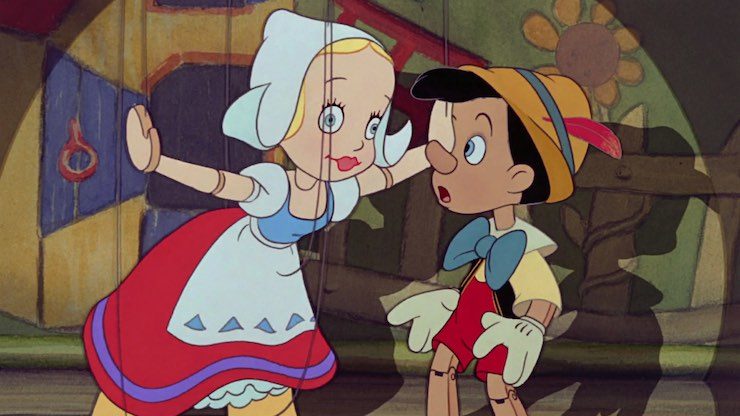
My first thought is The Windup Girl. My second is Magic, the old William Goldman thriller from the 1970s that was made into a movie with Anthony Hopkins and Ann Margret.
“Hugo” in the 1954 movie Dead of Night is still the definitive Evil Ventriloquist Doll for me. He’s the most tragic of monsters, trapped with his “master” in a relationship of mutual hatred and desperation that neither can escape from. Ray Bradbury inverted the trope in “And So Died Riabouchinska”, making the doll alter-ego the last dying decent part of a sorry individual. But these are tales of innocence compared to the dread and dehumanising “Greater Ventriloquism” of Jon Padgett’s 20 Simple Steps to Ventriloquism.
A couple of takes on “Pinocchio” that stick closer to Collodi than to Disney:
Higgins’ and Jensen’s graphic novel sequence Pinocchio Vampire Slayer. Collodi’s happy ending’s been blown to bits by dark forces, leaving a few characters standing in the wreckage. Fortunately, one is young and impetuous and angry and made of stuff that doesn’t bleed…
Chatterbox Audio Theatre‘s Pinocchio (parts one, two, three). Kyle Hatley has taken apart the original story and woven a brilliant alternative tale from the components. It’s a grim world, and Gepetto has a hard and costly fight for the safety of his wooden child.
(ahahaha this i my actual nightmare)
Cuckoo Song by Frances Hardinge: creepy dolls, eating dolls, is actually dolls; turns out to be more complex than dolls. The second half of this book is more fantasy-action, but the first half is super creepy and doll-oriented (thus the terrifying cover).
Splendors and Glooms by Laura Amy Schlitz is a middle grade novel about a child kidnapping connected to a puppeteer. To be honest, I read it three years ago and don’t really remember it, but my notes say it’s a combination of bewitching puppetry/enthusiastic gothic aesthetic and and unromanticized study of class in Victorian London, solidly successful if apparently not super memorable.
The Magic Toyshop by Angela Carter, a dreamy, fantastic, eerie, gothic coming of age set within the artifice and life-size dolls of an unusual toyshop.
The Adventures of Pinocchio is epically ridiculous. Mari Ness wrote a very spoilery but HILARIOUS review of it for the Disney Read-Watch: http://www.tor.com/2015/04/23/the-disney-readwatch-carlo-collodis-the-adventures-of-pinocchio/
When I was a child, I read a bunch of books by Rumer Godden about dolls who could think and feel, but couldn’t act– they were totally at the mercy of the children who owned them, and all they could do was wish for what they wanted. Which, to be fair, often worked, but I still found the whole idea kind of unsettling.
The film ‘Hugo’ features a most remarkable automaton.
Dianna Wynne-Jones “The Magicians of Caprona” and (if I remember correctly) Patricia Clapp’s “Jane Emily”